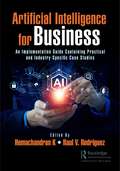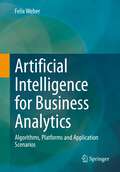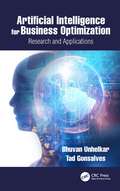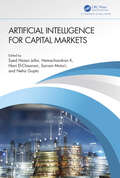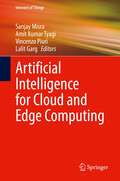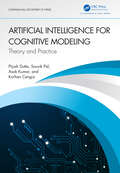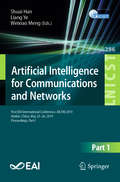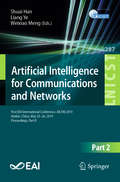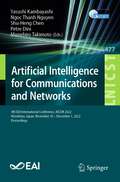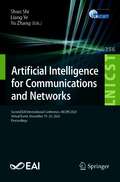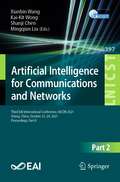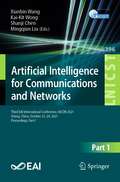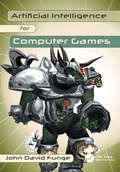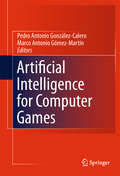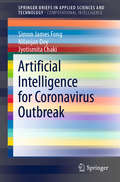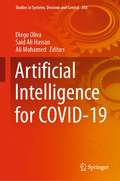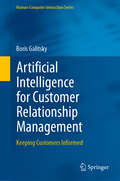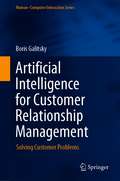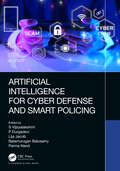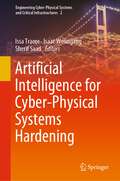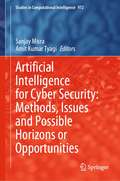- Table View
- List View
Artificial Intelligence for Business: An Implementation Guide Containing Practical and Industry-Specific Case Studies
Artificial intelligence (AI) is transforming the business world at an unprecedented pace. From automating mundane tasks to predicting consumer behaviour, AI is changing the way businesses operate across all sectors. This book is an exploration of AI in business applications, highlighting the diverse range of ways in which AI is being used across different industries. The book begins with an overview of AI in business and its impact on the workforce. It then explores the role of AI in marketing, advertising, and tourism. The use of AI in personalized recommendations and chatbots is discussed in detail. The book then moves on to examine how AI is changing the retail industry, improving supply chain management, and enhancing the customer experience. The media and entertainment industry is also examined, with a focus on how AI is being used to personalize content and improve the user experience. The book also explores the use of AI in human resources, insurance, legal, and finance. The impact of AI on talent identification, recruitment, underwriting, document analysis, and financial forecasting is discussed in detail. In the healthcare and sports industries, AI is transforming the way we approach diagnosis, treatment, and training. The book examines how AI is being used to analyse medical images, develop personalized treatment plans, and improve patient outcomes. The use of AI in sports performance analysis is also discussed in detail. Finally, the book explores the use of AI in agriculture, energy, education, and the public sector. The potential of AI to optimize crop yields, reduce energy consumption, and improve the quality of education is discussed in detail. The book also examines how AI is being used to improve public services, such as transportation and emergency services. This book is a valuable resource for academics, researchers, professionals, and policymakers who are interested in understanding the potential of AI in the business world. The contributions from leading experts and researchers provide a comprehensive overview of AI in business applications, and how it is transforming different sectors. The book also examines the ethical dilemmas that arise from the use of AI in business, such as the impact on privacy and data security, and the potential for bias in AI algorithms. It provides valuable insights into how businesses can ensure that the use of AI is ethical and responsible. In conclusion, this book is a must-read for anyone interested in the potential of AI in the business world. It provides a comprehensive overview of AI in business applications and how it is transforming different sectors. The book examines the ethical dilemmas that arise from the use of AI in business, providing valuable insights into how businesses can ensure that the use of AI is ethical and responsible. We hope that readers will find this book informative and thought-provoking.
Artificial Intelligence for Business Analytics: Algorithms, Platforms and Application Scenarios
by Felix WeberWhile methods of artificial intelligence (AI) were until a few years ago exclusively a topic of scientific discussions, today they are increasingly finding their way into products of everyday life. At the same time, the amount of data produced and available is growing due to increasing digitalization, the integration of digital measurement and control systems, and automatic exchange between devices (Internet of Things). In the future, the use of business intelligence (BI) and a look into the past will no longer be sufficient for most companies.Instead, business analytics, i.e., predictive and predictive analyses and automated decisions, will be needed to stay competitive in the future. The use of growing amounts of data is a significant challenge and one of the most important areas of data analysis is represented by artificial intelligence methods.This book provides a concise introduction to the essential aspects of using artificial intelligence methods for business analytics, presents machine learning and the most important algorithms in a comprehensible form using the business analytics technology framework, and shows application scenarios from various industries. In addition, it provides the Business Analytics Model for Artificial Intelligence, a reference procedure model for structuring BA and AI projects in the company.This book is a translation of the original German 1st edition Künstliche Intelligenz für Business Analytics by Felix Weber, published by Springer Fachmedien Wiesbaden GmbH, part of Springer Nature in 2020. The translation was done with the help of artificial intelligence (machine translation by the service DeepL.com). A subsequent human revision was done primarily in terms of content, so that the book will read stylistically differently from a conventional translation. Springer Nature works continuously to further the development of tools for the production of books and on the related technologies to support the authors.
Artificial Intelligence for Business Optimization: Research and Applications
by Bhuvan Unhelkar Tad GonsalvesThis is primarily a business book that discusses the research and associated practical application of artificial intelligence (AI) and machine learning (ML) in order to achieve business optimization (BO). AI comprises a wide range of technologies, databases, algorithms, and devices. This book aims for a holistic approach to AI by focusing on developing business strategies that will not only automate but also optimize business functions, processes, and people’s behaviors. Artificial Intelligence for Business Optimization: Research and Applications explores AI and ML from a business viewpoint with the key purpose of enhancing customer value. It applies research methods and fundamentals from a practitioner’s viewpoint and incorporates discussions around risks and changes associated with the utilization of AI in business. Furthermore, governance risks, privacy, and security are also addressed in this book to ensure compliance with AI/ML applications. Readers should find direct and practical applications of the discussions in this book quite useful in their work environment. Researchers will find many ideas to further explore the applications of AI to business.
Artificial Intelligence for Business Optimization: Research and Applications
by Bhuvan Unhelkar Tad GonsalvesThis is primarily a business book that discusses the research and associated practical application of artificial intelligence (AI) and machine learning (ML) in order to achieve business optimization (BO). AI comprises a wide range of technologies, databases, algorithms, and devices. This book aims for a holistic approach to AI by focusing on developing business strategies that will not only automate but also optimize business functions, processes, and people’s behaviors. Artificial Intelligence for Business Optimization: Research and Applications explores AI and ML from a business viewpoint with the key purpose of enhancing customer value. It applies research methods and fundamentals from a practitioner’s viewpoint and incorporates discussions around risks and changes associated with the utilization of AI in business. Furthermore, governance risks, privacy, and security are also addressed in this book to ensure compliance with AI/ML applications. Readers should find direct and practical applications of the discussions in this book quite useful in their work environment. Researchers will find many ideas to further explore the applications of AI to business.
Artificial Intelligence for Capital Markets
by Syed Hasan Jafar K Hemachandran Hani El-Chaarani Sairam Moturi Neha GuptaArtificial Intelligence for Capital Market throws light on the application of AI/ML techniques in the financial capital markets. This book discusses the challenges posed by the AI/ML techniques as these are prone to "black box" syndrome. The complexity of understanding the underlying dynamics for results generated by these methods is one of the major concerns which is highlighted in this book. Features: Showcases artificial intelligence in finance service industry Explains credit and risk analysis Elaborates on cryptocurrencies and blockchain technology Focuses on the optimal choice of asset pricing model Introduces testing of market efficiency and forecasting in the Indian stock market This book serves as a reference book for academicians, industry professionals, traders, finance managers and stock brokers. It may also be used as textbook for graduate level courses in financial services and financial analytics.
Artificial Intelligence for Capital Markets
by Syed Hasan Jafar Hemachandran K Hani El-Chaarani Sairam Moturi Neha GuptaArtificial Intelligence for Capital Market throws light on the application of AI/ML techniques in the financial capital markets. This book discusses the challenges posed by the AI/ML techniques as these are prone to "black box" syndrome. The complexity of understanding the underlying dynamics for results generated by these methods is one of the major concerns which is highlighted in this book. Features: Showcases artificial intelligence in finance service industry Explains credit and risk analysis Elaborates on cryptocurrencies and blockchain technology Focuses on the optimal choice of asset pricing model Introduces testing of market efficiency and forecasting in the Indian stock market This book serves as a reference book for academicians, industry professionals, traders, finance managers and stock brokers. It may also be used as textbook for graduate level courses in financial services and financial analytics.
Artificial Intelligence for Cloud and Edge Computing (Internet of Things)
by Vincenzo Piuri Sanjay Misra Lalit Garg Amit Kumar TyagiThis book discusses the future possibilities of AI with cloud computing and edge computing. The main goal of this book is to conduct analyses, implementation and discussion of many tools (of artificial intelligence, machine learning and deep learning and cloud computing, fog computing, and edge computing including concepts of cyber security) for understanding integration of these technologies. With this book, readers can quickly get an overview of these emerging topics and get many ideas of the future of AI with cloud, edge, and in many other areas. Topics include machine and deep learning techniques for Internet of Things based cloud systems; security, privacy and trust issues in AI based cloud and IoT based cloud systems; AI for smart data storage in cloud-based IoT; blockchain based solutions for AI based cloud and IoT based cloud systems.This book is relevent to researchers, academics, students, and professionals.
Artificial Intelligence for Cognitive Modeling: Theory and Practice (Chapman & Hall/CRC Internet of Things)
by Pijush Dutta Souvik Pal Asok Kumar Korhan CengizThis book is written in a clear and thorough way to cover both the traditional and modern uses of artificial intelligence and soft computing. It gives an in-depth look at mathematical models, algorithms, and real-world problems that are hard to solve in MATLAB. The book is intended to provide a broad and in-depth understanding of fuzzy logic controllers, genetic algorithms, neural networks, and hybrid techniques such as ANFIS and the GA-ANN model. Features A detailed description of basic intelligent techniques (fuzzy logic, genetic algorithm and neural network using MATLAB) A detailed description of the hybrid intelligent technique called the adaptive fuzzy inference technique(ANFIS) Formulation of the nonlinear model like analysis of ANOVA and response surface methodology Variety of solved problem on ANOVA and RSM Case studies of above mentioned intelligent techniques on the different process control systems This book can be used as a handbook and a guide for students of all engineering disciplines, operational research areas, computer applications, and for various professionals who work in the optimization area.
Artificial Intelligence for Cognitive Modeling: Theory and Practice (Chapman & Hall/CRC Internet of Things)
by Pijush Dutta Souvik Pal Asok Kumar Korhan CengizThis book is written in a clear and thorough way to cover both the traditional and modern uses of artificial intelligence and soft computing. It gives an in-depth look at mathematical models, algorithms, and real-world problems that are hard to solve in MATLAB. The book is intended to provide a broad and in-depth understanding of fuzzy logic controllers, genetic algorithms, neural networks, and hybrid techniques such as ANFIS and the GA-ANN model. Features A detailed description of basic intelligent techniques (fuzzy logic, genetic algorithm and neural network using MATLAB) A detailed description of the hybrid intelligent technique called the adaptive fuzzy inference technique(ANFIS) Formulation of the nonlinear model like analysis of ANOVA and response surface methodology Variety of solved problem on ANOVA and RSM Case studies of above mentioned intelligent techniques on the different process control systems This book can be used as a handbook and a guide for students of all engineering disciplines, operational research areas, computer applications, and for various professionals who work in the optimization area.
Artificial Intelligence for Communications and Networks: First EAI International Conference, AICON 2019, Harbin, China, May 25–26, 2019, Proceedings, Part I (Lecture Notes of the Institute for Computer Sciences, Social Informatics and Telecommunications Engineering #286)
by Shuai Han Liang Ye Weixiao MengThis two-volume set LNICST 286-287 constitutes the post-conference proceedings of the First EAI International Conference on Artificial Intelligence for Communications and Networks, AICON 2019, held in Harbin, China, in May 2019. The 93 full papers were carefully reviewed and selected from 152 submissions. The papers are organized in topical sections on artificial intelligence, mobile network, deep learning, machine learning, wireless communication, cognitive radio, internet of things, big data, communication system, pattern recognition, channel model, beamforming, signal processing, 5G, mobile management, resource management, wireless position.
Artificial Intelligence for Communications and Networks: First EAI International Conference, AICON 2019, Harbin, China, May 25–26, 2019, Proceedings, Part II (Lecture Notes of the Institute for Computer Sciences, Social Informatics and Telecommunications Engineering #287)
by Shuai Han Liang Ye Weixiao MengThis two-volume set LNICST 286-287 constitutes the post-conference proceedings of the First EAI International Conference on Artificial Intelligence for Communications and Networks, AICON 2019, held in Harbin, China, in May 2019. The 93 full papers were carefully reviewed and selected from 152 submissions. The papers are organized in topical sections on artificial intelligence, mobile network, deep learning, machine learning, wireless communication, cognitive radio, internet of things, big data, communication system, pattern recognition, channel model, beamforming, signal processing, 5G, mobile management, resource management, wireless position.
Artificial Intelligence for Communications and Networks: 4th EAI International Conference, AICON 2022, Hiroshima, Japan, November 30 - December 1, 2022, Proceedings (Lecture Notes of the Institute for Computer Sciences, Social Informatics and Telecommunications Engineering #477)
by Yasushi Kambayashi Ngoc Thanh Nguyen Shu-Heng Chen Petre Dini Munehiro TakimotoThis book, AICON 2022, constitutes the post-conference proceedings of the 4th EAI International Conference on Artificial Intelligence for Communications and Networks, AICON 2022, held in Hiroshima, Japan, in November 30- December 1, 2022. The 9 full papers and 4 short papers were carefully reviewed and selected from 36 submissions. The papers detail research in the areas of AI and communication systems related to intelligent systems and computational intelligence for communication and networks. They are organized in topical sections on AI and networks; machine learning; and evolutionary computation.
Artificial Intelligence for Communications and Networks: Second EAI International Conference, AICON 2020, Virtual Event, December 19-20, 2020, Proceedings (Lecture Notes of the Institute for Computer Sciences, Social Informatics and Telecommunications Engineering #356)
by Shuo Shi Liang Ye Yu ZhangThis book constitutes the post-conference proceedings of the Second EAI International Conference on Artificial Intelligence for Communications and Networks, AICON 2020, held in December 2020. Due to COVID-19 pandemic the conference was held virtually.The 52 full papers were carefully reviewed and selected from 112 submissions. The papers are organized in topical sections on Deep Learning/Machine Learning on Information and Signal Processing; AI in Ubiquitous Mobile Wireless Communications; AI in UAV-assisted wireless communications; Smart Education: Educational Change in the age of artificial Intelligence; AI in SAR/ISAR Target Detection; Recent advances in AI and their applications in future electronic and information field.
Artificial Intelligence for Communications and Networks: Third EAI International Conference, AICON 2021, Xining, China, October 23–24, 2021, Proceedings, Part II (Lecture Notes of the Institute for Computer Sciences, Social Informatics and Telecommunications Engineering #397)
by Xianbin Wang Kai-Kit Wong Shanji Chen Mingqian LiuThis two-volume set LNICST 396 and 397 constitutes the post-conference proceedings of the Third EAI International Conference on Artificial Intelligence for Communications and Networks, AICON 2021, held in September 2021. Due to COVID-19 pandemic the conference was held virtually. The 79 full papers were carefully reviewed and selected from 159 submissions. The papers are organized in topical sections on Artificial Intelligence in Wireless Communications and Satellite Communications; Artificial Intelligence in Electromagnetic Signal Processing; Artificial Intelligence Application in Wireless Caching and Computing; Artificial Intelligence Application in Computer Network.
Artificial Intelligence for Communications and Networks: Third EAI International Conference, AICON 2021, Xining, China, October 23–24, 2021, Proceedings, Part I (Lecture Notes of the Institute for Computer Sciences, Social Informatics and Telecommunications Engineering #396)
by Xianbin Wang Kai-Kit Wong Shanji Chen Mingqian LiuThis two-volume set LNICST 396 and 397 constitutes the post-conference proceedings of the Third EAI International Conference on Artificial Intelligence for Communications and Networks, AICON 2021, held in September 2021. Due to COVID-19 pandemic the conference was held virtually. The 79 full papers were carefully reviewed and selected from 159 submissions. The papers are organized in topical sections on Artificial Intelligence in Wireless Communications and Satellite Communications; Artificial Intelligence in Electromagnetic Signal Processing; Artificial Intelligence Application in Wireless Caching and Computing; Artificial Intelligence Application in Computer Network.
Artificial Intelligence for Computer Games: An Introduction
by John David FungeLearn to make games that are more fun and engaging! Building on fundamental principles of Artificial Intelligence, Funge explains how to create Non-Player Characters (NPCs) with progressively more sophisticated capabilities. Starting with the basic capability of acting in the game world, the book explains how to develop NPCs who can perceive, remem
Artificial Intelligence for Computer Games
by Pedro Antonio González-Calero Marco Antonio Gómez-MartínThe book presents some of the most relevant results from academia in the area of Artificial Intelligence for games. It emphasizes well theoretically supported work supported by developed prototypes, which should lead into integration ofacademic AI techniques into current electronic entertainment games.The book elaborates on the main results produced in Academia within the last 10 years regarding all aspects of Artificial Intelligence for games, including pathfinding, decision making, and learning. A general theme of the book is thecoverage of techniques for facilitating the construction of flexible not prescripted AI for agents in games. Regarding pathfinding, the book includes new techniques for implementing real-time search methods that improve the results obtained through AI, as well as techniques for learning pathfinding behavior by observing actual players.Regarding decision making, the book describes new techniques for authoring tools that facilitate the construction by game designers (typically nonprogrammers) of behavior controlling software, by reusing patterns or actualcases of past behavior. Additionally, the book will cover a number of approaches proposed for extending the essentially pre-scripted nature of current commercial videogames AI into a more interactive form of narrative, where the story emerges from the interaction with the player. Some of those approachesrely on a layered architecture for the character AI, including beliefs, intentions and emotions, taking ideas from research on agent systems. The book also includes chapters on techniques for automatically or semiautomatically learning complex behavior from recorded traces of human or automatic players using different combinations of reinforcement learning, case-based reasoning, neural networks and genetic algorithms.
Artificial Intelligence for Coronavirus Outbreak (SpringerBriefs in Applied Sciences and Technology)
by Simon James Fong Nilanjan Dey Jyotismita ChakiThis book examines how the wonders of AI have contributed to the battle against COVID-19. Just as history repeats itself, so do epidemics and pandemics. In the face of the novel coronavirus disease, COVID-19, the book explores whether, in this digital era where artificial intelligence is successfully applied in all areas of industry, we are doing any better than our ancestors did in dealing with pandemics. One of the most contagious diseases ever known, COVID-19 is spreading like wildfire around and has cost thousands of human lives.The book discusses how AI can help fight this deadly virus, from early warnings, prompt emergency responses, and critical decision-making to surveillance drones. Serving as a technical reference resource, data analytic tutorial and a chronicle of the application of AI in epidemics, this book will appeal to academics, students, data scientists, medical practitioners, and anybody who is concerned about this global epidemic.
Artificial Intelligence for COVID-19 (Studies in Systems, Decision and Control #358)
by Diego Oliva Said Ali Hassan Ali MohamedThis book presents a compilation of the most recent implementation of artificial intelligence methods for solving different problems generated by the COVID-19. The problems addressed came from different fields and not only from medicine. The information contained in the book explores different areas of machine and deep learning, advanced image processing, computational intelligence, IoT, robotics and automation, optimization, mathematical modeling, neural networks, information technology, big data, data processing, data mining, and likewise. Moreover, the chapters include the theory and methodologies used to provide an overview of applying these tools to the useful contribution to help to face the emerging disaster. The book is primarily intended for researchers, decision makers, practitioners, and readers interested in these subject matters. The book is useful also as rich case studies and project proposals for postgraduate courses in those specializations.
Artificial Intelligence for Customer Relationship Management: Keeping Customers Informed (Human–Computer Interaction Series)
by Boris GalitskyThis research monograph brings AI to the field of Customer Relationship Management (CRM) to make a customer experience with a product or service smart and enjoyable. AI is here to help customers to get a refund for a canceled flight, unfreeze a banking account or get a health test result. Today, CRM has evolved from storing and analyzing customers’ data to predicting and understanding their behavior by putting a CRM system in a customers’ shoes. Hence advanced reasoning with learning from small data, about customers’ attitudes, introspection, reading between the lines of customer communication and explainability need to come into play.Artificial Intelligence for Customer Relationship Management leverages a number of Natural Language Processing (NLP), Machine Learning (ML), simulation and reasoning techniques to enable CRM with intelligence. An effective and robust CRM needs to be able to chat with customers, providing desired information, completing their transactions and resolving their problems. It introduces a systematic means of ascertaining a customers’ frame of mind, their intents and attitudes to determine when to provide a thorough answer, a recommendation, an explanation, a proper argument, timely advice and promotion or compensation. The author employs a spectrum of ML methods, from deterministic to statistical to deep, to predict customer behavior and anticipate possible complaints, assuring customer retention efficiently. Providing a forum for the exchange of ideas in AI, this book provides a concise yet comprehensive coverage of methodologies, tools, issues, applications, and future trends for professionals, managers, and researchers in the CRM field together with AI and IT professionals.
Artificial Intelligence for Customer Relationship Management: Solving Customer Problems (Human–Computer Interaction Series)
by Boris GalitskyThe second volume of this research monograph describes a number of applications of Artificial Intelligence in the field of Customer Relationship Management with the focus of solving customer problems. We design a system that tries to understand the customer complaint, his mood, and what can be done to resolve an issue with the product or service. To solve a customer problem efficiently, we maintain a dialogue with the customer so that the problem can be clarified and multiple ways to fix it can be sought. We introduce dialogue management based on discourse analysis: a systematic linguistic way to handle the thought process of the author of the content to be delivered. We analyze user sentiments and personal traits to tailor dialogue management to individual customers. We also design a number of dialogue scenarios for CRM with replies following certain patterns and propose virtual and social dialogues for various modalities of communication with a customer. After we learn to detect fake content, deception and hypocrisy, we examine the domain of customer complaints. We simulate mental states, attitudes and emotions of a complainant and try to predict his behavior. Having suggested graph-based formal representations of complaint scenarios, we machine-learn them to identify the best action the customer support organization can chose to retain the complainant as a customer.
Artificial Intelligence for Cyber Defense and Smart Policing
by S. Vijayalakshmi, P. Durgadevi, Lija Jacob, Balamurugan Balusamy, and Parma NandThe future policing ought to cover identification of new assaults, disclosure of new ill-disposed patterns, and forecast of any future vindictive patterns from accessible authentic information. Such keen information will bring about building clever advanced proof handling frameworks that will help cops investigate violations. Artificial Intelligence for Cyber Defense and Smart Policing will describe the best way of practicing artificial intelligence for cyber defense and smart policing.Salient Features:• Combines AI for both cyber defense and smart policing in one place.• Covers novel strategies in future to help cybercrime examinations and police.• Discusses different AI models to fabricate more exact techniques.• Elaborates on problematization and international issues.• Includes case studies and real-life examples.This book is primarily aimed at graduates, researchers, and IT professionals. Business executives will also find this book helpful.
Artificial Intelligence for Cyber Defense and Smart Policing
The future policing ought to cover identification of new assaults, disclosure of new ill-disposed patterns, and forecast of any future vindictive patterns from accessible authentic information. Such keen information will bring about building clever advanced proof handling frameworks that will help cops investigate violations. Artificial Intelligence for Cyber Defense and Smart Policing will describe the best way of practicing artificial intelligence for cyber defense and smart policing.Salient Features:• Combines AI for both cyber defense and smart policing in one place.• Covers novel strategies in future to help cybercrime examinations and police.• Discusses different AI models to fabricate more exact techniques.• Elaborates on problematization and international issues.• Includes case studies and real-life examples.This book is primarily aimed at graduates, researchers, and IT professionals. Business executives will also find this book helpful.
Artificial Intelligence for Cyber-Physical Systems Hardening (Engineering Cyber-Physical Systems and Critical Infrastructures #2)
by Issa Traore Isaac Woungang Sherif SaadThis book presents advances in security assurance for cyber-physical systems (CPS) and report on new machine learning (ML) and artificial intelligence (AI) approaches and technologies developed by the research community and the industry to address the challenges faced by this emerging field. Cyber-physical systems bridge the divide between cyber and physical-mechanical systems by combining seamlessly software systems, sensors, and actuators connected over computer networks. Through these sensors, data about the physical world can be captured and used for smart autonomous decision-making. This book introduces fundamental AI/ML principles and concepts applied in developing secure and trustworthy CPS, disseminates recent research and development efforts in this fascinating area, and presents relevant case studies, examples, and datasets. We believe that it is a valuable reference for students, instructors, researchers, industry practitioners, and related government agencies staff.
Artificial Intelligence for Cyber Security: Methods, Issues and Possible Horizons or Opportunities (Studies in Computational Intelligence #972)
by Sanjay Misra Amit Kumar TyagiThis book provides stepwise discussion, exhaustive literature review, detailed analysis and discussion, rigorous experimentation results (using several analytics tools), and an application-oriented approach that can be demonstrated with respect to data analytics using artificial intelligence to make systems stronger (i.e., impossible to breach). We can see many serious cyber breaches on Government databases or public profiles at online social networking in the recent decade. Today artificial intelligence or machine learning is redefining every aspect of cyber security. From improving organizations’ ability to anticipate and thwart breaches, protecting the proliferating number of threat surfaces with Zero Trust Security frameworks to making passwords obsolete, AI and machine learning are essential to securing the perimeters of any business. The book is useful for researchers, academics, industry players, data engineers, data scientists, governmental organizations, and non-governmental organizations.
